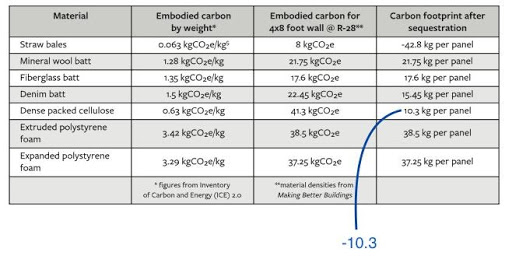A few years ago I came across ultra-insulated high efficiency fridges, like this now discontinued SunFrost design.
Extra thick insulated walls are only part of the reason those are so efficient, but I figured, is it possible to at least get kinda close by adding extra insulation to the outside of a normal fridge? For many fridges, the answer is yes!
This old post from a 2012 eco-modding forum claims that, using just regular old styrofoam, they were able to cut down the energy use of their old energy-hog fridge from 274kWh per year down to 128kWh per year! (And they wrote a little guide on how they did it too).
Those sorta numbers kinda blew my mind. Not only is it possible to save more than half in yearly electricity costs, it also keeps an old fridge out of the landfill instead of being replaced with a modern, more efficient one. And bear in mind, that’s just with styrofoam, which according to this handy little chart, has an R-Value of 4 per inch (High density EPS, i.e, Expanded Polystyrene, is what is usually referred to when we say styrofoam). Imagine what sort’ve numbers they could’ve got with proper insulating foam with an R-value of 10 or 13 per inch!
I was able to find another post on this topic over on reddit, which brings up the biggest downside of doing this modification: It’s ugly.
I think that could be negated somewhat if you’re creative and painted the foam (it’d probably look cool if you painted it white or black and sprayed a solarpunk logo with a stencil on it), but I suspect for most, this will be a dealbreaker for a main kitchen fridge (not to mention, you may not have enough clearance for the extra foam in your… Fridge slot?)
Still though, those power saving numbers are difficult to ignore, and I could see people going for this on secondary a garage fridge, like the dude in the second link did. It would have a dramatic effect in energy consumption if the ambient temperature around your fridge is usually pretty hot, as hotter outside temps dramatically increase energy useage.

Now you can’t do this to any 'ol fridge or freezer. Some designs dissipate their heat through the metal skin of the fridge itself, and covering it with foam would quickly destroy it. But if your fridge has a visible condenser coil somewhere, either on the back of the fridge, or underneath, you’re probably good to go as long as those coils remain uncovered and can get adequate airflow per their design specs.
I think this modification is probably best suited for older, less efficient fridges, where it’ll give the most noticeable benefit in energy and cost savings. But if you did apply it to a modern high efficiency fridge, you could probably get near the efficiency of a factory-made ultra-insulated fridge (which currently go for a whopping $2,150!) for a fraction of the price.
EDIT: Found some more numbers in this video. Using 3/4" foam (less R-value), the guy in the vid achieved a 20% reduction in energy use. In comments, another person reported a 45% reduction in energy use after applying 1" foam.
What I wouldn’t mind is a chest-style fridge.
They’re shockingly efficient (no, really: the cold air won’t fall out, so they use dramatically less power) but, for whatever reason, there’s no such thing, just freezers.
Chest freezer with an aftermarket temperature controller. Commonly called a “keezer” in the homebrewing community.
Iirc, this is mostly a myth. The majority of the thermal mass in a fridge is the stuff in it, and the temperature of the stuff doesn’t move nearly that much from just opening the door briefly.
The reason chest fridges arent that popular is the inconvenience of having a bunch of liquid jugs and fresh food stored in a pile as opposed to on shelves.
Not a myth. What’s inside the fridge doesn’t really matter when talking about efficiency. It pretty much only depends on the rate at which energy seeps into the fridge from outside. All else being equal, chest fridges allow significantly less heat transfer through an open door than regular fridges, and are therefore a more efficient design.
You’re completely right about the second part, though. It’s just not practical, and the fact you would have to keep the door open longer while you rummage around for stuff renders the point moot anyway.
Not a myth…and the fact you would have to keep the door open longer while you rummage around for stuff renders the point moot anyway.
So they are correct in a practical sense but not in a scientific theory?
they are incorrect about the reason but accidentally correct about the outcome
That just reminds me about 10th grade geometry.
What do you mean I have to show my work? I got the answer right, didn’t I?
I’m correct because the door is closed nearly always. The difference in performance with the door open is barely relevant.
it’s not really a myth, see for yourself with the ugliest link ever: https://www.energystar.gov/productfinder/product/certified-residential-freezers/results?search_text=&sort_by=annual_energy_use_kwh_yr&sort_direction=asc&page_number=0&lastpage=0&search-1=&type_filter=Chest+Freezer&type_filter=Upright+Freezer&is_most_efficient_filter=0&capacity_total_volume_ft3_filter=7+-+13.9&capacity_total_volume_ft3_filter=14+-+21.9&markets_filter=United+States
you’ll notice that by capacity chest freezers are more efficient. There are a lot of factors stacked in their favor though:
- cold air sinks as mentioned above, while not the majority of the thermal mass in a fridge you lose quite a bit every time anyway.
- convection is a lot stronger than people often realize, and upright freezers are more prone to unforced convection, especially because of the aforementioned air loss (replaced by warm air flowinginto and out of)
So I looked at link and I’m not sure this is making anyone’s point but mine. I don’t dispute that a chest freezer is more efficient, just not massively so. It looks like 15-20% more efficient for a chest vs upright, which is not shocking at all. And a fridge with it’s smaller gap to ambient will get less of a benefit. The air inside just isn’t that hard to cool and door is closed the overwhelming majority of the time.
well you can define when the efficiency is impressive or not to you, now people can go look at the numbers. 20% is pretty substantial, but if you are disappointed it’s not 90% then i dont know what to tell ya
You can easily make one by adding a thermostat inline with the power cord to a chest freezer.
They kind of exist in the form of car fridges
Very cool post (pun intended).
This got me thinking about the goal of this kind of insulation…
If it’s cost savings, what would be the timespan until the cost of the styrofoam is paid for by the energy savings? ( I have no idea what that type of styrofoam costs).
If the goal is environmental, how much energy savings would be needed to offset the footprint of the manufacture of the styrofoam and transport of the styrofoam to your location?
In either case, I’d have to assume the less efficient (and older) the fridge, the faster you’d make the extra insulation pay itself off.
Ideally it’d be done with reclaimed materials, like the second guy who used old insulation from an RV.
But at least in my area from a local hardware store, I can buy 1.5 inch 4x8ft sheets of expanded polystyrene insulation for $20 per sheet. 3 sheets should be enough for most fridges (or 4, if the heat exchanger is underneath the fridge), so 60 to $80 for new materials.
Using this energy star savings calculator, it spits out this rough estimate of the yearly cost of a 1990’s fridge:

If the foam decreases energy usage by 50%, that would mean a $115 savings within the first year, paying off the initial foam costs within 6 months of use.
According to that same calculator, this is the numbers they give regarding carbon emissions compared to using a new energy efficient fridge:

It’s difficult to find the information of expanded polystyrene’s carbon footprint, I think I found it here? Specifically this chart from that article:

The second column there can be ignored, since we’re not trying to achieve R28, which since XPS foam is pretty low R value compared to other foam insulators would take a LOT of foam. So I guess the first column is the relevant one.
Holy shit this is some #theydidthemath stuff.
6 months at paying full price for the foam is a ridiculously quick turnaround given the lifespan of a fridge (easily 5 years). Plus, you can probably reuse the prior fridge’s foam on the next fridge, so that makes it even better.
Why don’t people do this more often? If the gap in my current “fridge space” wasn’t so small already, I’d be tempted to go find some foam.
My only question is where is the outlet for the heat pump? If it goes out in the front then okay, but if it’s pumping out hot air into a now insulated area that might be a problem
I would guess that most people don’t know, and as mentioned it’s ugly and sadly it seems the majority of people care about aesthetics more than efficiency.
And also like you, I would do this but my fridge space is also definitely too small. I also think our fridge is new enough to be one of the metal dissipators
I don’t know where you live. But where I live, styrofoam costs next to nothing. In fact, you get it for free, if you don’t mind looking through another man’s trash. You can also probably get some for free if you ask a company, that gets stuff sent, that need cooling. Like a supermarket.
For environment: styrofoam is a kind of plastic, so there is that. On the plus side, it’s quite little plastic inflated with air.
I assume it’s way better than getting a replacement fridge, especially considering the electronics and maybe the coolant gas (I don’t know if that’s still an issue).
I wouldn’t be surprised if the electricity saved alone offsets the environment damage (assuming not fully green power used to run the fridge).
Excellent point about getting styrofoam for free (I hadn’t even thought of that). With that in mind, the only cost would be for time spent gathering the foam and then covering the fridge (I could probably do this in less than an hour, tbh).
Thanks for this comment!
I’d also worry about flammability. I’m not up on the various insulators like Styrofoam when it comes to its flash point, or if shorts could set it off when improvised like that.
The 2012 forum guy actually made a post about that topic here. According to this site, it can catch fire from a sufficiently hot spark, but its auto-ignition temperature is fairly high.
There does exist some styrofoams with flame retardant in them, but that would probably have to be sought out specifically.
You could probably build a nice looking enclosure for a fridge and would look better than foam
My fridge in a fridge in a fridge. Where’s the milk?
The enclosure would decrease efficiency, not increase it. Many fridges have heat exchange pipes along the outer walls, insulating them would cause the phase change to take longer, requiring more on time for the compressor.
Of course you would need a fridge with exposed coils and a way to route the heat away. I’d look for one that’s designed to be built-in and does the air exchange at the front/bottom.
I have a counter-height wine fridge designed like this.
You mean like a shell to go around the foam? That would make it take up even more space, but it could be a cool project for someone who doesn’t mind. :)
I’m thinking more like build a cabinet/walls around. If done right it would look built-in.




